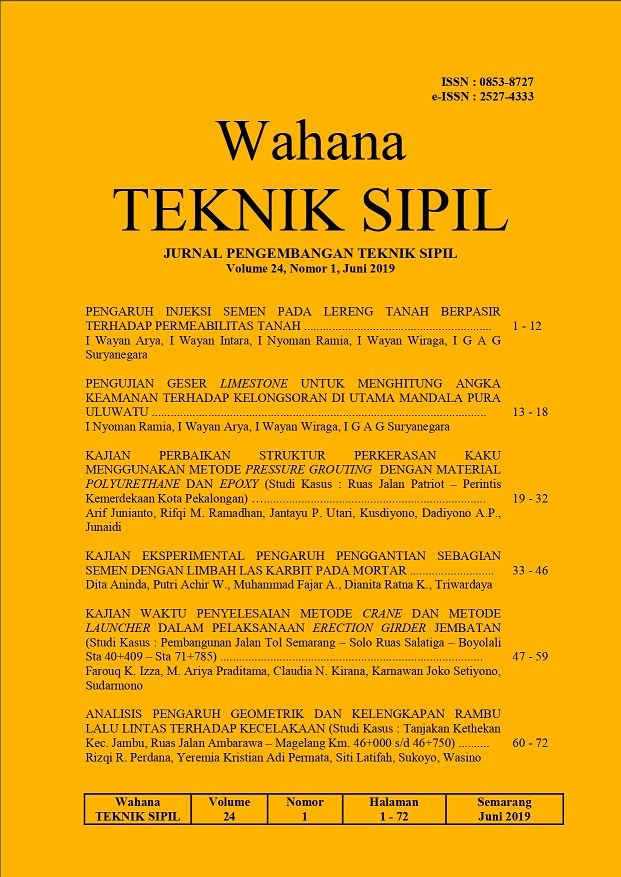KAJIAN PERBAIKAN STRUKTUR PERKERASAN KAKU MENGGUNAKAN METODE PRESSURE GROUTING DENGAN MATERIAL POLYURETHANE DAN EPOXY (Studi Kasus : Ruas Jalan Patriot ”“ Perintis Kemerdekaan Kota Pekalongan)
DOI:
https://doi.org/10.32497/wahanats.v23i1.1604Keywords:
crete crack repair, pressure grouting, polyurethane, epoxyAbstract
Today the implementation of road infrastructure development using concrete pavement is experiencing rapid development because it can serve heavy and heavy traffic loads. But there are some problems that often arise in the use of concrete for pavement, causing damage (cracks). Repair of concrete cracks using pressure grouting method is one solution that can be used to improve the strength of concrete. This study discusses the comparison of the effectiveness of using polyurethane and epoxy materials in an effort to improve the rigid pavement structure. The research method used was to carry out repairs to the concrete structure on the Independence Patriotic-Road Section of Pekalongan City using polyurethane and epoxy materials. In this study each of the 5 existing normal (non-damaged) concrete samples, concrete repaired with polyurethane material and repaired concrete using epoxy material using core drill method, which will then be tested for compressive strength in the laboratory, as well as hammer test testing. to find out the strength of the existing concrete damage. The results showed that the average compressive strength of normal existing concrete (not damaged) amounted to 59.20 N/mm2, the average compressive strength of concrete that experienced cracks was 27.04 N/mm2, the average compressive strength value of repair concrete using polyurethane material is 31.92 N/mm2 (increasing by 15.17%) and the average compressive strength of concrete repair using epoxy material is 45.22 N/mm2 (increased by 56.53%).References
Aggarwal, L.K., Thapliyal, P.C., Karade, S.R., 2007, Properties of Polymer Modified Mortars Using Epoxy and Acrylic Emulsion. Construction and Building Material. Vol.21, Hal.379-383.
Alfredo, D., Hutomo, K., Sudjarwo, P., Buntro. J., 2014, Analisa Penyebab dan Metode Perbaikan yang Tepat pada Beton yang Disebabkan oleh Faktor Non-Struktural. Tesis Program Studi Teknik Sipil Universitas Kristen Petra Surabaya. Jurnal Dimensi Pratama Teknik Sipil. Vol.3, No.2, Hal.1-5.
Dachlan, A.T, 2010, Metode Pelaksanaan Evaluasi Perbaikan Jalan Beton Dengan Injeksi Semen, Cor di Tempat Dan Beton Pra Cetak. Jurnal Jalan ”“ Jembatan. Vol.27, No.2, Hal.125-142.
Isneini, M., 2009, Analisis Modulus Elastisitas Lentur Terhadap Loss Factor Beton Polimer. Jurnal Rekayasa. Vol.13, No.1, Hal.67-76.
Kementerian Pekerjaan Umum dan Perumahan Rakyat, 2015, Pedoman Penstabilan Dan Pengembalian Elevasi Pelat Beton Dengan Cara Grouting Pada Perkerasan Kaku. Surat Edaran Menteri PUPR No. 27. Jakarta
Kusdiyono, 2012, Bahan Bangunan 2, Penerbit Polines Semarang. Semarang.
Primasasti, D.K., 2010, Tinjauan Kuat Tekan dan Kuat Lentur Repair Mortar Dengan Bahan Tambah Polymer. Skripsi Jurusan teknik Sipil Fakultas Teknik Universitas Sebelas Maret. Surakarta.
Supardi., 2013, Evaluasi Kerusakan Jalan Pada Perkerasan Rigid dengan Menggunakan Metode Bina Marga (Studi Kasus Ruas Jalan Sei Durian Rasau Jaya km 21 + 700 s.d km 24 + 700). Jurnal Garuda. Vol 13, No. 1, Hal. 129-138.
Yurmansyah, I., Mukhlisin, 2009, Perkuatan Struktur Beton Gedung dengan Metode Grouting dan Glass Fiber. Jurnal Rekayasa Sipil. Vol.V, No.1, Hal.46-59.
Downloads
Published
Issue
Section
License
Authors who publish with this journal agree to the following terms:Authors retain copyright and grant the journal right of first publication with the work simultaneously licensed under a Creative Commons Attribution License that allows others to share the work with an acknowledgement of the work's authorship and initial publication in this journal.
Authors are able to enter into separate, additional contractual arrangements for the non-exclusive distribution of the journal's published version of the work (e.g., post it to an institutional repository or publish it in a book), with an acknowledgement of its initial publication in this journal.
Authors are permitted and encouraged to post their work online (e.g., in institutional repositories or on their website) prior to and during the submission process, as it can lead to productive exchanges, as well as earlier and greater citation of published work (See The Effect of Open Access).






